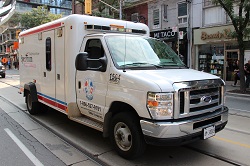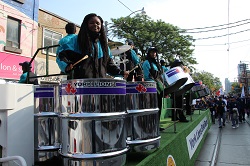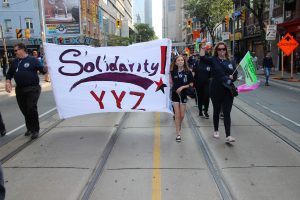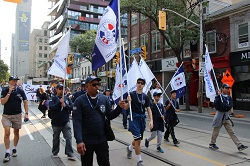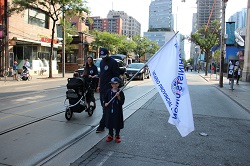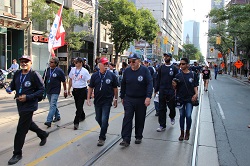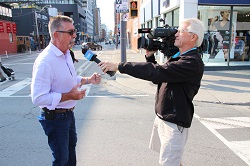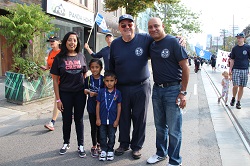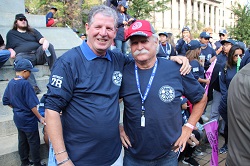Toronto, ON – Labour Day in Canada was declared a National holiday back in 1894 and trade unionists have been marching through the streets of Toronto and across the country on the first Monday of September ever since.
Labour Day 2017 in Toronto was highlighted by the largest turnout of Machinist members on record, in excess of 250 IAM members marched the 7 kilometer route from the heart of downtown Toronto to the grounds of the Canadian National Exhibition. “This was a solid turnout, perhaps one of the best we have ever had. It was a great day for a walk through Sunny Toronto streets, and our members came out to show Solidarity and support of working people in Toronto and across Canada,” said IAM Canadian General Vice President Stan Pickthall.
Lead by the Spectrum Patient Services ambulance float, members and their families kept their rhythm courtesy of the Caribbean beat of the York Lions Steel Band, who never let up from the start of the parade to the finish. “With ever-greater challenges facing workers, Labour Day is an opportunity to show the community the scope and diversity of the IAM and our great Labour movement,” said Pickthall.
Labour Day in Canada has its roots in Toronto. By 1872, the Toronto Printers Union had been lobbying its employers for over three years for a shorter work week. Inspired by workers in Hamilton who had begun the movement for a nine-hour work day, the Toronto printers threatened to strike if their demands weren’t met. Tired of being ignored by their employers, the workers took bold action and on March 25, 1872, they went on strike.
Toronto’s publishing industry underestimated the resolve of the printers and the support they had garnered with this action, the industry was paralyzed and the printers soon had the support of other workers. On April 14, a group of 2,000 workers marched through the streets in a show of solidarity. They picked up even more supporters along the way and by the time they reached their destination of Queen’s Park, their parade had 10,000 participants – one tenth of the city’s population.
Led by George Brown, founder of the Toronto Globe and notable Liberal, the publishers retaliated. Brown brought in workers from nearby towns to replace the printers. He even took legal action to quell the strike and had the strike leaders charged and arrested for criminal conspiracy.
Conservative Prime Minister John A. Macdonald, a crafty politician, watched the events unfold and quickly saw the political benefit of siding with the workers. Macdonald spoke out against Brown’s actions at a public demonstration at City Hall. Not only did he embarrass his Liberal rival he also gained the support of the workers. Macdonald passed the Trade Union Act, which repealed the outdated British law and decriminalized unions. The strike leaders were released from jail.
This strike proved that workers could gain the attention of their employers, the public, and most importantly, the political leaders if they worked together. The “Nine-Hour Movement,” as it became known, spread to other Canadian cities and a shorter work week became the primary demand of union workers in the years following the Toronto strike.
The parade that was held in support of the strikers carried over into an annual celebration of worker’s rights and was adopted in cities throughout Canada. The parades demonstrated solidarity, with different unions identified by the colorful banners they carried. In 1894, under mounting pressure from the working class, Prime Minister Sir John Thompson declared Labour Day a national holiday.
So whether you’re marching in a show of solidarity through the streets of your city, flipping burgers on the barbecue or catching rays at the beach on Labour Day, take a moment to thank our labour pioneers. Like so many things we take for granted today – a forty hour work week, consecutive days off, weekends off, paid overtime, paid benefits, annual holidays like Labour Day and annual vacation – it’s all brought to you by your union.





